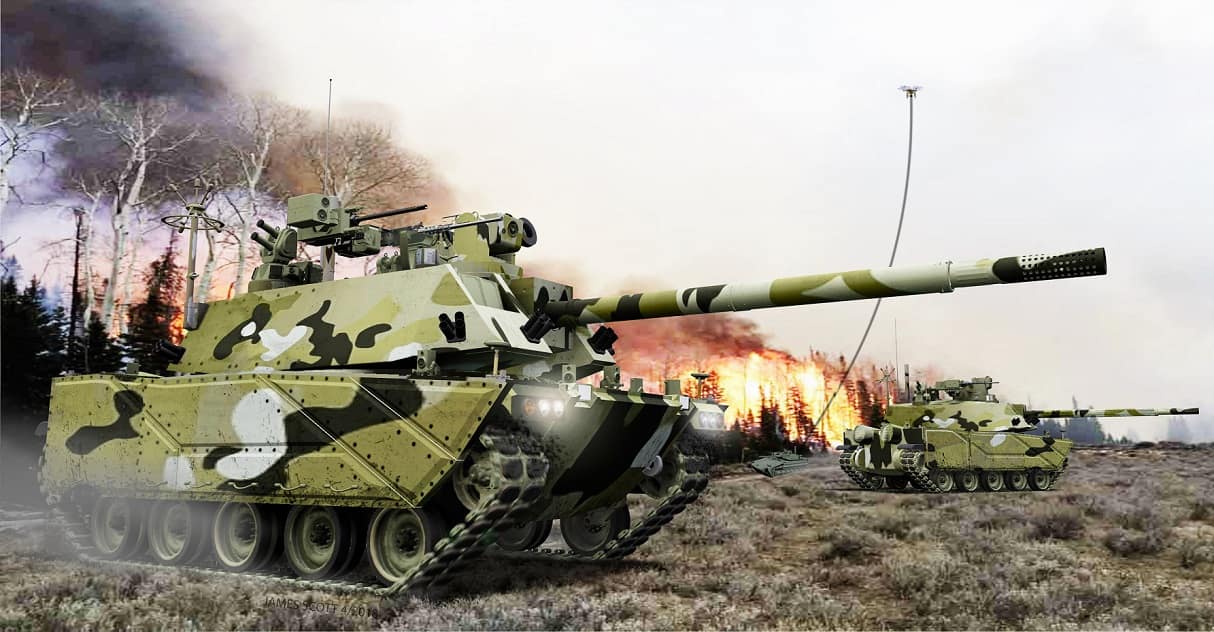The U.S. Army has released declassified conceptual look at what the Next Generation Combat Vehicle could eventually look like.

In an op-ed for the Army News Service, Douglas Scott (CCDC C5ISR Center Public Affairs) has added some images showed Next Generation Combat Vehicle’s manned-unmanned teaming concept.
The article refers to a “the Army Futures Command, or AFC, is using iterative field experimentation to help the Army take a revolutionary step in the evolution of armored warfare.” But our attention was attracted by the visualization of the concept, which for the first time demonstrates the features of the Army’s combat vehicles of the future.
According to the article, the Next Generation Combat Vehicle’s manned-unmanned teaming concept would leverage a protected tether between the NGCV Optionally Manned Fighting Vehicle and the Robotic Combat Vehicle in order to provide Soldiers with the capability to safely engage in combat via remotely controlled autonomous systems.
The new generation of combat vehicles is intended to replace the Bradley starting in 2026 and is designed to better operate in future environments that would allow soldiers to maneuver to a position of advantage and to engage in close combat and deliver decisive lethality during the execution of combined arms maneuver.
It expected that will be developed three variants of special Robotic Combat Vehicle for work with the manned vehicle. The first variant called the RCV-Light will weigh approximately seven tons and include a sensor bundle that will allow the platform to deliver lethal fires. The RCV-Medium will weigh about 10 tons and be equipped with a medium-caliber weapon cannon and an anti-tank guided missile. And the RCV-Heavy will weigh about 20 tons with direct-fire lethal capabilities. It has assumed that on Article’s images showed the RCV-Heavy variant.
Army officials envision the light version to be transportable by rotary wing. The medium variant would be able to fit onto a C-130 aircraft, and the heavy variant would fit onto a C-17 aircraft.
Last week, the Army News Service also has reported that Soldiers to fire at targets next year using a platoon of robotic combat vehicles they will control from the back of modified Bradley Fighting Vehicles.
The monthlong operational test is scheduled to begin in March at Fort Carson, Colorado, and will provide input to the Combat Capabilities Development Command’s Ground Vehicle Systems Center on where to go next with autonomous vehicles.
The upgraded Bradleys, called Mission Enabler Technologies-Demonstrators, or MET-Ds, have cutting-edge features such as a remote turret for the 25 mm main gun, 360-degree situational awareness cameras and enhanced crew stations with touchscreens.
Initial testing will include two MET-Ds and four robotic combat vehicles on M113 surrogate platforms. Each MET-D will have a driver and gunner as well as four Soldiers in its rear, who will conduct platoon-level maneuvers with two surrogate vehicles that fire 7.62 mm machine guns.